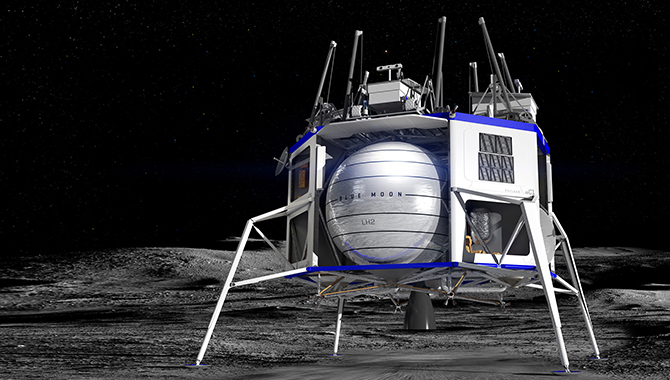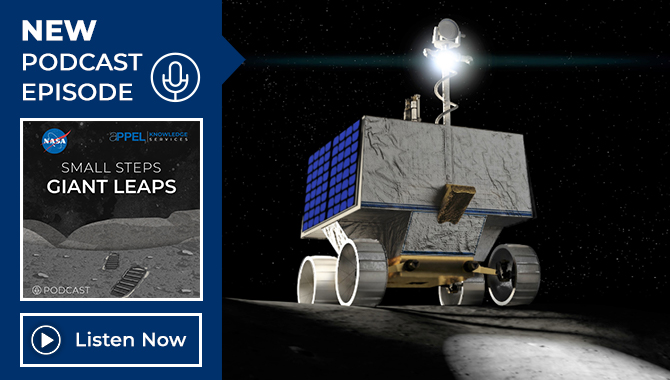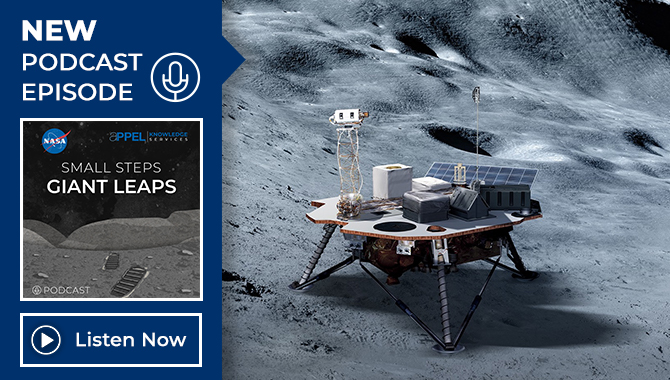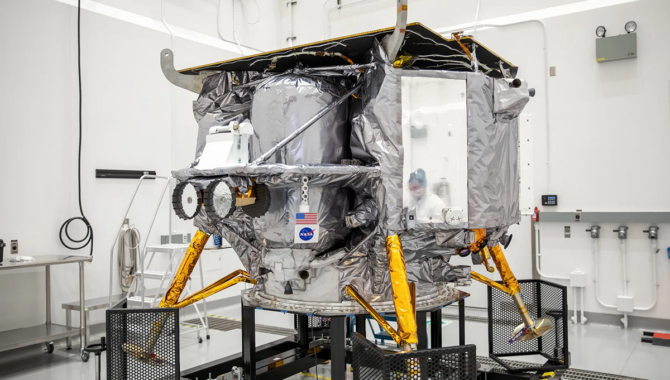
Teams have installed the NASA Insignia on Astrobotic’s Peregrine Lander in advance of a mission to the Moon that could launch as soon as December 24, 2023. The lander will carry five NASA-sponsored payloads to the lunar surface as part of the Commercial Lunar Payload Services initiative. Photo Credit: NASA/Isaac Watson
Commercial landers will deliver science payloads in 2024.
In early 2024, shortly after the Sun rises over the Moon’s enigmatic Gruithuisen Domes, a commercial lander is scheduled to descend to the lunar surface carrying five NASA-sponsored science payloads. It will be the first spaceflight in NASA’s innovative Commercial Lunar Payload Services (CLPS) initiative.
Astrobotic, an aerospace firm in Pittsburgh, is supplying its Peregrine Lander for the mission, which will liftoff atop a United Launch Alliance Vulcan Rocket no earlier than December 24, 2023, arriving at the Moon in about 12 days. The spacecraft will first establish a broad elliptical orbit as far as 5,590 miles from the lunar surface and as close as 62 miles, before drawing closer into a parking orbit of about 466 miles by 62 miles. Finally, it will orbit at a steady 62 miles above the Moon before beginning its autonomous descent.
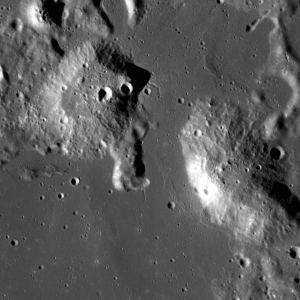
The Gruithuisen Domes, seen in an image captured by the Lunar Reconnaissance Orbiter Camera. Image Credit: NASA/GSFC/Arizona State University
The Gruithuisen Domes rise high above a plain of ancient basaltic lava. The smallest is about 12.5 miles in diameter and nearly a mile high. The largest is 16.7 miles in diameter and 1.1 miles high. But it’s the domes’ composition that intrigues scientists.
Observations by NASA’s Lunar Reconnaissance Orbiter indicate the material of the domes is distinct from the surrounding area. Lunar scientists theorize the domes could have been formed from thick, silica-rich magma and are currently granite-like. However, such formations on Earth are created through the interaction of plate tectonics and liquid water. With neither on the Moon, the domes are a mystery.
“Characterizing the emplacement history of these Gruithuisen Domes relative to episodes of mare volcanism is a really important component of understanding the entire history of the region,” said Ryan Watkins, Program Scientist in NASA’s Exploration Science Strategy and Integration Office, speaking at a recent NASA media teleconference.
NASA plans to land an experiment known as the Lunar Vulkan Imaging and Spectroscopy Explorer (Lunar-VISE) on one of the domes in 2026 or 2027. Lunar-VISE will use a combined lander and rover payload to determine the composition and physical properties of the domes, which will help scientists better understand how they could have formed.
“And so, our current Astrobotic payload manifest includes several instruments that are going to take measurements of this mare region that surrounds the domes. That will complement the Lunar-VISE measurements. Multi-spectral measurements of both the mare and the domes will help us to understand mixing of the materials on the domes,” Watkins said.
The five NASA payloads the spacecraft will carry are:
The Peregrine Ion-Trap Mass Spectrometer (PITMS), which will gather data about the presence and variability of the OH, H2O, noble gases, nitrogen, and sodium compounds that are released from the Moon’s regolith and travel through the exosphere over the course of the long lunar day.
The Neutron Spectrometer System (NSS), which will determine the abundance of hydrogen-bearing materials and the bulk regolith composition at the landing site up to a depth of three feet below the surface and measure any variations during the diurnal cycle.
The Lunar Retroreflector Array (LRA), a dome-shaped object with eight 1.25-cm diameter glass corner cube prism retroreflectors mounted to the lander deck. The LRA can bounce laser light from other orbiting and landing spacecraft, functioning as a permanent location marker on the Moon for decades to come.
The Near Infrared Volatile Spectrometer System (NIRVSS), which will measure surface and subsurface hydration (H2O and OH) as well as CO2 and methane, while simultaneously mapping surface morphology and surface temperatures.
The Linear Energy Transfer Spectrometer (LETS), a solid-state silicon Timepix detector, that will quantify radiation at the lunar surface from Galactic Cosmic Rays—high-energy particles that zip into our solar system from distant points in the galaxy—and from space weather caused by the Sun.
The lunar surface is especially harsh, with daytime temperatures at the landing site near Gruithuisen Domes reaching about 230° Fahrenheit during the day and falling below -320° Fahrenheit when the Sun sets and through the long lunar night of about 14 Earth days.
“Typically, with temperatures in that range, there’s lots of things that break,” said John Thornton, CEO of Astrobotic. “Battery chemistries aren’t happy with that. Basically, we expect the spacecraft to have some problems through that night and probably not be able to survive. That’s what history tells us with lunar missions on the surface.”
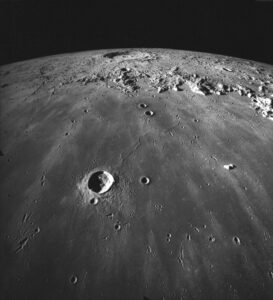
Apollo 17, 1972: this oblique photograph was taken looking south across Mare Imbrium. Photo Credit: NASA
Because the Moon has a very thin and tenuous atmosphere, a spacecraft can’t utilize parachutes or atmospheric friction to slow its rate of descent, relying instead on thrusters. Communication delays between Earth and the Moon mean that robotic spacecraft need to fire these thrusters and perform landing procedures autonomously.
“Only about half of the missions that have gone to the surface of the Moon have been successful, so it’s certainly a daunting challenge,” said Thornton, who noted that the Peregrine Lander has passed extensive testing to reach this point. “We’ve done as much as we possibly can here on Earth to ensure mission success, but we are up against one of the most challenging environments known to man. … I’m going to be terrified and thrilled all at once at every stage of this.”
The CLPS initiative is leveraging the innovation and the entrepreneurship of American private industry to build a robust delivery infrastructure to the Moon featuring multiple vendors and eventually with NASA as just one of many customers. NASA currently has six landings slotted for 2024, including delivery of the VIPER rover to examine water ice deposits at the Moon’s south pole.
“If there are American companies providing a delivery service to the Moon, we feel that the cost of buying a service should be much less than NASA owning a custom end-to-end mission,” said Dr. Joel Kearns, the Deputy Associate Administrator for Exploration in NASA’s Science Mission Directorate, speaking at the teleconference. “It’s really exciting to kick off a new American adventure on the Moon starting this December. As part of Artemis, robotic spacecraft will conduct important scientific studies in the near future and then later in parallel with exploration by astronauts on the Moon.”








